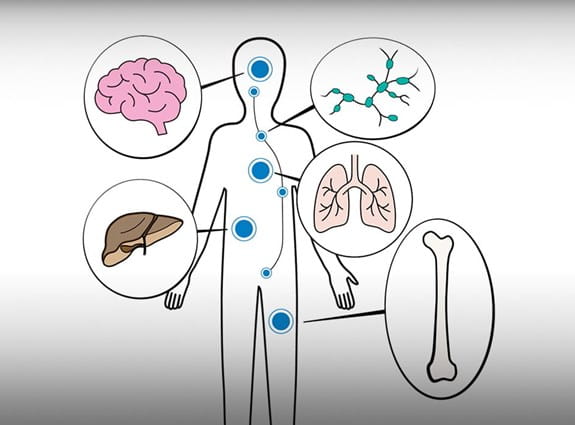What is metastatic cancer?
[The narrator appears on screen. He has recently been diagnosed with metastatic (advanced) cancer. A thought bubble appears showing him a few years ago receiving chemotherapy.]
Narrator: I was diagnosed with cancer a few years ago and was cancer-free after the treatment.
[The narrator’s doctor appears on screen sitting at a desk. They are talking to each other in her office.]
Narrator: But at a recent follow-up appointment, my doctor told me I now have metastatic cancer.
[A thought bubble with a question mark appears above the narrator’s head.]
Narrator: I didn’t know what that meant.
[The doctor stands next to an outline of a human body. A red dot appears in the middle of the abdomen of the outline. Red rings radiate out from the dot suggesting it is spreading.]
Narrator: My doctor explained that metastatic cancer is cancer that has spread from where it started to another part of the body.
[The red dot and rings fade out. The doctor points at the body outline and a new dot appears where the colon is located. An arrow points from that dot to a smaller dot in the liver area. The doctor disappears and the screen zooms in on the torso of the body outline.]
Narrator: The original cancer is called the primary cancer. When the original cancer spreads to another part of the body, it is called metastatic cancer. Metastatic cancer has the same type of cancer cells as the primary cancer.
[A drawing of a colon appears beside the colon area of the body. A drawing of a liver appears beside the liver area. The animation shows tiny dots moving from the colon to the liver.]
Narrator: So, for example, if colon cancer spreads to the liver, the cancer cells in the liver are colon cancer cells. It is called metastatic colon cancer, not liver cancer.
[The full body outline reappears. Drawings of lymph nodes (in various parts of the body), a thigh bone (femur), the brain, the liver and the lungs appear with lines pointing to where they are located in the body.]
Narrator: Cancer can spread anywhere in the body, but it commonly spreads to the lymph nodes, the bones, the brain, the liver or the lungs.
[The body drawing moves to the right of the screen. The narrator appears on the left looking at it.]
Narrator: Sometimes metastatic cancer can be found in a new location in the body after the original cancer was treated – like in my case. This is called recurrent.
[The scene changes. The doctor appears seated at her desk. A circle with test result pages appears next to her.]
Narrator: Metastatic cancer may also be found when you are first diagnosed. You may hear it called stage 4 cancer.
[The screen splits into 2 scenes. In the first scene, the narrator is walking his dog in a park. In the second scene, the narrator is sitting at a table enjoying tea with 2 friends.]
Narrator: My doctor told me that the goal of treatment for metastatic cancer is to help a person live as long as possible and maintain their quality of life.
[A panel of healthy cells (yellow) and cancer cells (blue, irregular shaped) appears on screen. Next to it, images of a pill bottle, an IV bag and radiation machine appear.]
Narrator: Treatment controls and slows the growth of the metastatic cancer, but it doesn’t usually make the cancer go away completely.
[The narrator appears on screen looking concerned.]
Narrator: Hearing this made me scared and confused. I didn’t know what to do next.
[The screen splits into 2 panels. On one side, the narrator is holding a cellphone to his ear. On the other side, an information specialist from the Canadian Cancer Society is wearing a headset and sits at a desk with a computer.]
Narrator: The doctor suggested that I contact
the Canadian Cancer Society.
[Speech bubbles appear next to the narrator and information specialist, indicating they’re having a telephone conversation.]
Narrator: They have information specialists who took the time to answer all my questions and made me feel more prepared for what came next.
[A large circle appears in the middle of the narrator and information specialist. It shows a street map with various location pins.]
Narrator: They referred me to services in my community to help me out.
[The narrator sits at a desk looking at a computer monitor. Images of a cellphone, a laptop and a tablet appear next to him.]
Narrator: They also suggested I visit their website, cancer.ca, where I found more information on metastatic cancer …
[The scene shows the narrator sitting on a chair. Three circles with images of different people appear, and all are connected by lines to each other and the narrator.]
Narrator: … and even connected with other people who have metastatic cancer, too. It was comforting to know I wasn’t alone.
[The narrator appears close up and shows the expression on his face changing from worried to more relaxed.]
Narrator: Being told you have metastatic cancer can make you feel a lot of different emotions like shock, fear, worry, sadness and anger. I know I did. And that’s OK.
[Three circles appear next to the narrator, showing the doctor, the information specialist and one of the other people with metastatic cancer shown previously.]
Narrator: Everyone reacts differently, but just know you are not alone. Supports are available to you.
[The Canadian Cancer Society logo appears above the contact number and website. The BMO bank logo appears below as a sponsor of the Cancer Basics videos.]
Narrator: The Canadian Cancer Society is here to help. Visit cancer.ca or call 1-888-939-3333.

